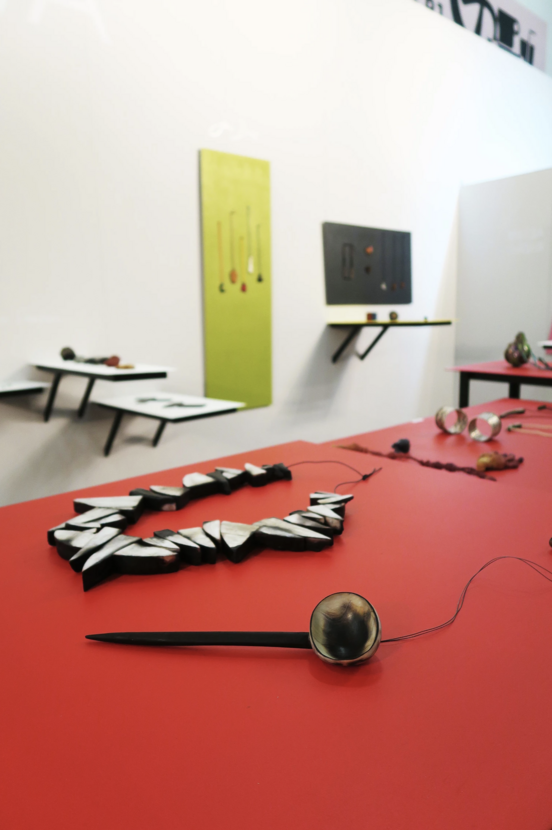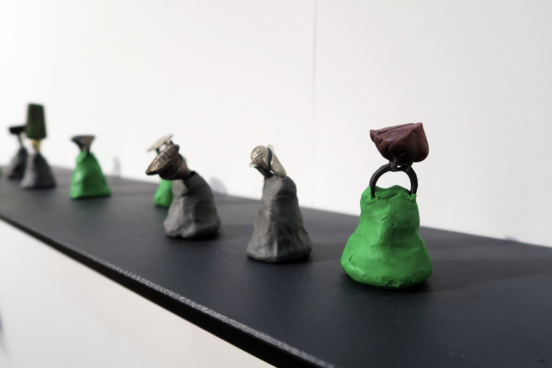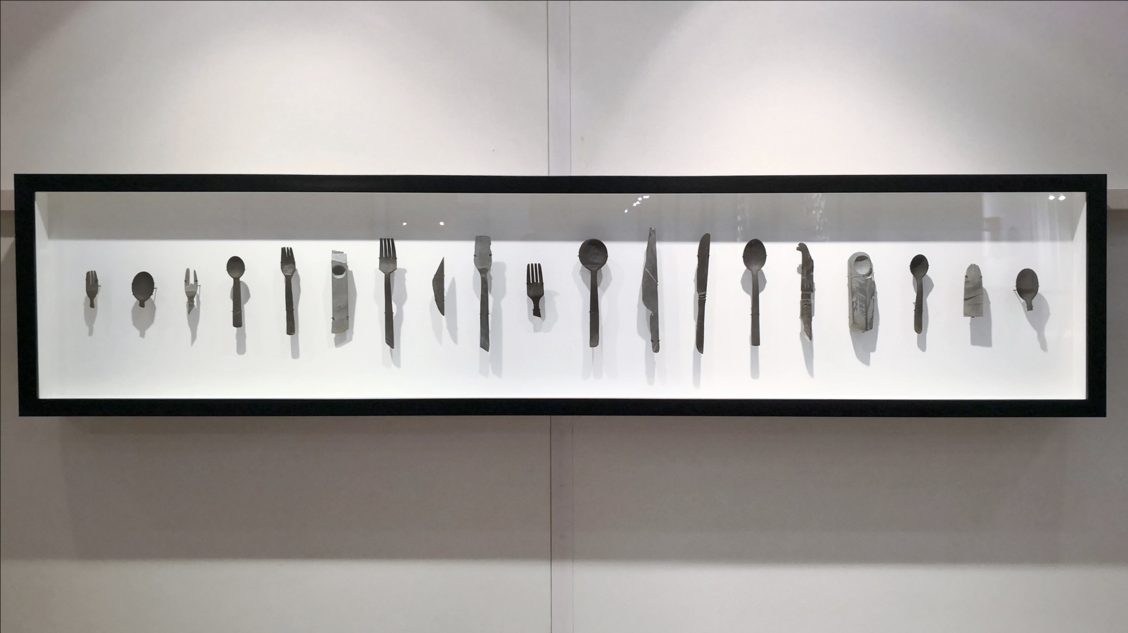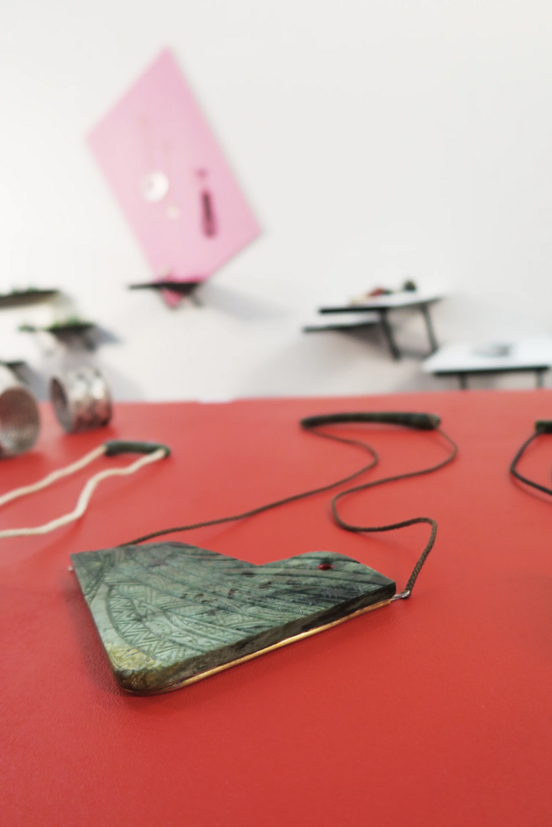-
Author
Kim Paton -
Date
9 May 2018
Essay
Valuing the Handmade
New Zealand Jewellers in Munich
In March of every year, one of the most important events on the international contemporary jewellery calendar is held in a vast exhibition hall in an unexceptional suburb of Munich. It is the type of venue where, on ticketed entry, families and young professional couples battle crowds on grey Sunday afternoons. To wander through trade displays curated on high rotation on any number of themes—green building, tech futures, Italian design, home and living—week to week.
Established in 1959 Schmuck is one of the oldest contemporary jewellery exhibitions in the world. Beginning as a special exhibition at the week-long Internationale Handwerksmesse, it operates within this vast international trade fair for the skilled trades, where hundreds of exhibitors are drawn from categories such as kitchen, construction, technology and craft. The hall is populated with demonstrations illustrating specialised making techniques, walking aisle to aisle glass blowers, bread makers or wood carvers might be found installed beside a live full-scale roof thatching demonstration.
For a first-time visitor it is an unlikely location to find contemporary jewellers, gallerists, students, writers and collectors congregating from around the world. However, its importance and popularity has produced a citywide boom of gallery and museum exhibitions, events and self-initiated artist projects. Coined Munich Jewellery Week in 2015, it occupies vacant sites, window fronts, and public spaces throughout the inner city.
Schmuck’s presence at the Handwerksmesse has grown as a three-part exhibition system focusing on the different stages of a maker’s development, each is highly competitive with significant international profile and reach. Participants for Schmuck are selected by a different guest curator annually, the exhibition attracts established and senior jewellers, many of whom are well-known and acclaimed internationally. Adjacent to Schmuck, Talente draws applications for new work from early career makers and designers (entrants must be under the age of 33) from a wider discipline field including jewellery, metal, glass, ceramics and typography; this year 110 exhibitors were selected from 30 countries. Tracing the perimeter of the Schmuck and Talente exhibitions, a third section titled FRAME hosts a small group of international commercial galleries in prefab booths, their presence at the Handwerksmesse continues to be a significant attraction for contemporary jewellery collectors. In the context of the much-visited trade fair, the relative niche of the art jewellery field (and the collection of expert audiences that travel to it every year) are also exposed to general audiences on a strange and staggering scale, thousands of people trawl through the exhibitions and in-and-out of the booths that line FRAME.
Since the early 1990s New Zealand has sustained a presence at Munich. This connection with Europe is emblematic of the wider maturation of what is now an internationally regarded New Zealand contemporary jewellery field. Key relationships between a handful of New Zealand jewellers; Alan Preston, Warwick Freeman, Peter Deckers, Lisa Walker and Karl Fritsch; with gallerists, jewellers and curators internationally—as well as a continued programme of visitors to New Zealand—have established vital pathways for the success of jewellers in Munich.
This year, third-year Whitireia Institute of Technology student Renee Pearson (taught under Peter Deckers) became the first New Zealander to win the Talente Prize in the stone category, for her series of fragmented cutlery forms carved from greywacke stone. In 2014 fellow New Zealvander Samantha Lewis took out the same prize for typography. Whitireia alumni Grace Yu Piper was also selected for the exhibition alongside Pearson with two pendant works carved from jade and greywacke, interweaving a pair of singular geometric forms. Lisa Walker and Karl Fritsch—both greatly celebrated in Munich, and students of Professor Otto Kunzli at the Munich Arts Academy in the early 2000s— were selected for the Schmuck exhibition. Walker for her 2015 Fischli and Weiss Bracelet, a bombastic circular form of interconnecting stiletto heels. It is a work that embodies an exuberant power, one that demonstrates little interest in arguments for or against any inherent material preciousness. Instead appropriating found materials for what curator Felicity Milburn describes as Walker “draw[ing] out the inherent contradictions of everyday life as she sees – and makes us see – the world in all its startling strangeness.” 1 With a not dissimilar prowess Fritsch’s work deceptively subverts traditional ideas of craftsmanship. His two rings, installed centrally in a large glass cabinet are off-beat and absurd. One, a wavering bullet shape of elongated synthetic ruby extends from a classical gold setting. On the other, Fritsch has inscribed in a loose script a droll personal message to the Schmuck selector.
For the third year a New Zealand presence returned to FRAME curated by Peter Deckers - in 2013 and 2017 with exhibitions from his Handshake project, and this year in a more conventional dealer gallery format. Well known jeweller and educator Deckers, is head tutor of Whitireia’s jewellery programme, in 2011 he developed the Handshake project, as a mentoring system pairing New Zealand-based jewellers, just out of tertiary education, with their creative idol. The pedagogy supporting Handshake is based on the old apprentice model but re-tuned to contemporary shifts in modes of practice and learning, and is driven flexibly by the mentees needs. Within this framework early-career jewellers are matched with a powerhouse of expertise and esteem within their given discipline area – Karl Fritsch, Liesbeth den Besten, Ruudt Peters and Lisa Walker to name a few. The mentorship extends over years and is populated with regular and demanding deadlines for its participants including extensive exhibition projects internationally.
In New Zealand and internationally, Handshake has been heralded for its openness, its collegiality, and for encouraging criticality and experimentation in a maker’s practice once outside of formal education. Distinct for its strong international focus and a self-determined sense of vitality, Handshake has played a critical role in continuing to strengthen the reception of work by New Zealand jewellers (and more widely the field specific to a New Zealand context) internationally. At FRAME the Handshake projects takes on a particular and canny role for expanding international audiences to New Zealand jewellers, as most of the mentor partners are acclaimed internationally with high profiles in Munich. Exhibited side by side, or for Handshake 3 collaborating together, the partnerships that form the basis of the project additionally provide an authority and appeal for the international community.
Catalysed by a funding opportunity through Creative New Zealand (New Zealand’s national arts development agency), this year Deckers returned with the exhibition IWA: New Zealand Makers. Developed to draw more directly on the dealer gallery environment of FRAME, the show focused on nine (iwa in Māori) jewellers spanning three generations of making. The exhibition design utilised vertical and horizontal surfaces with colour treatments responding to each artist, a technique frequently employed by Deckers in Handshake exhibitions. The presentation demonstrated a strong mix of high profile jewellers including Warwick Freeman, Alan Preston, Lisa Walker and Karl Fritsch; alongside Jane Dodd, Shelley Norton and Moniek Schrijer all of whom have been selected for Schmuck previously, Schrijer won the prestigious Herbert Hofmann prize in 2016. Three Hofmann prizes are awarded annually, selected from the Schmuck exhibition by an independent jury. The prize is esteemed in the jewellery community, creating exposure for winning jewellers that can lead to international dealer representation, exhibitions and residencies.

Work by Nina van Duynhoven (foreground) at IWA: New Zealand Makers, Handwerksmasse, Munich, 2018. Photo courtesy of IWA.

Karl Fritsch display at IWA: New Zealand Makers, Handwerksmasse, Munich, 2018. Photo courtesy of IWA.

Renee Pearson, Last Supper, 2017. Winner of Talenta Prize, Handwerksmasse, Munich, 2018. Photo courtesy of IWA.
IWA sat within a small run of some of the most well-known dealer jewellery galleries in the world. There is no doubt that Deckers’ prolific international network continued to draw support for the booth, however it is arguable whether the focused commercialised role of the IWA exhibition is the right use of Deckers inimitable skills and resources. Previous Handshake projects provided a rich and innovative offering within the relative consistency of the booths that line FRAME. This year targeted funding from Creative New Zealand orientated the IWA project toward a direct commercial model. Bringing with it the multiple nuanced demands of selling in an international environment, where gallerists offer collectors expertise particular to the wider market, and the security of a relationship that can be sustained with a gallery long-term.
Deckers has also experimented with bringing similar projects to the inner-city Munich Jewellery Week environment, where audiences expect to encounter more experimental and critically engaged projects. But he is passionate about the benefit and exposure concentrated in the activity at the fair. In a 2014 round up of Munich Jewellery Week for magazine Art News New Zealand, Deckers suggests the period of true innovation emblematic of the jewellery movement might be dwindling as participants develop projects arguably focused on the expanding collector market. “I’ve begun to realise that the ‘jewelleryness’ is being eclipsed by just jewellery. ‘Jewelleryness’ is about the idea and concept, often set in a particular context. jewellery is about the work ready to be sold”. 2 Deckers argues that within this wider changing field, the juried competition framework for Schmuck and Talente, with its wide international reach and profile, continues to attract true experimentation and creativity.
The quality of the curatorial selections in IWA was indisputably strong and the project effectively maintained a continued New Zealand role at Munich. A presence best illustrated by a stunning list of prior accolades included Areta Wilkinson and Alan Preston’s prestigious keynote presentation at the Pinakothek der Moderne in 2016; Freeman being celebrated as “Meister der Moderne” (Classic of the Modern) at Schmuck in 2013; and Freeman and Fritsch’s major curated Wunderrūma: New Zealand Jewellery exhibition which was shown at Munich’s Gallery Handwerk in 2014 and then toured throughout New Zealand. Alongside the extensive list of New Zealand jewellers and designers who have exhibited in Talente and Schmuck every year.
The nine jewellers selected by Deckers map plot lines in the development of contemporary jewellery as an established field in New Zealand. Recent work by celebrated senior practitioner Alan Preston, a simple threaded necklace of painted banana seeds sits alongside early work of Warwick Freeman, his 1994 work Blossom sees three simple scallop shells set effortlessly in gold and silver. Both works illustrate the continued vitality and influence of the Bone Stone Shell movement, a period catalysed in the 1980s by practitioners looking to the Pacific and local natural materials for inspiration, instead of European traditions and material sources that had dominated the field prior. Exhibited alongside Fritsch and Walker, as well as other early career jewellers including Vanessa Arthur and Moniek Schrijer, a breadth of distinct material sources is evident in IWA - discarded, precious, found or foraged. Coupled with an exhaustive list of making processes, the exhibition Illustrated the complexity and rigour of current jewellery practice in New Zealand.
Arguably though, there is a short-sightedness to the way in which IWA manifested this year. Having Deckers operate within a dealer format (in contrast to his previous exhibition focused iterations) was largely a result of the structure and nature of the funding available to achieve a New Zealand presence at the fair in 2018. It highlights the largely untapped potential of New Zealand gallerists to have a presence at Munich or more widely within the burgeoning international market for design and applied arts focused fairs such as Collect or Design Miami. It also points to a relatively weak and reactionary infrastructure for New Zealand-led international projects in the craft/object sectors.
While the contemporary jewellery community in New Zealand remains in good health, like wider applied making practices it continues to face diminishing support institutionally in New Zealand. In 2016 Creative New Zealand made changes to the way it funds projects at Munich, removing comprehensive support for Talente, including the previous paid mentor position. Formerly occupied by jewellers Fran Allison and more recently Renee Bevan, who shepherded young practitioners through the application process, maintained networks in Munich and implemented a visitor’s programme for the NZ contingent traveling over yearly. Further to this in late 2017 Manukau Institute of Technology announced the closure of its renowned contemporary jewellery school in what has been a decade of similar closures, leaving few remaining avenues for undergraduate study in jewellery throughout the country.
Now more than ever informal channels of engagement and activity that can continue to develop the field in New Zealand are crucial. A characteristic of the history of contemporary jewellery in New Zealand are the lines of connection and exchange established between New Zealand and parts of Europe. Established at a time when New Zealand’s relative geographical isolation and limited channels for communication profoundly influenced the work of artists and writers post World War II. The arrival of four European jewellers in the 1960s – Kobi Bosshard (Switzerland), Günter Taemmler (East Germany), Tanya Ashken (England) and Jens Hansen (Denmark) – marks the dominant period that was a catalyst for the development of the field 3.
Establishing themselves in practice in New Zealand, they engendered avenues for education. Workshops, apprenticeships, shared workshop models and visits from other notable European jewellers provided opportunities for what was then a group of largely self-taught New Zealand jewellers. A funded visit to New Zealand in 1982 by renowned German jeweller Herman Junger catalysed a later invitation to Warwick Freeman and Alan Preston to exhibit at Schmuck, and subsequently to Preston to become a selector of New Zealand work for the exhibition annually. Decades later an argument could be made that not a great deal has changed. Progress and development internationally continues to be driven by the determination of a handful of individuals who have existing networks in place and who have been in the game long enough to understand the value of these connections, particularly within a comparatively young and fragile ecosystem locally.
With dwindling opportunities for tertiary study in New Zealand, opportunities offered through projects like Handshake and Talente are disproportionately important. The imperfect solution to New Zealand at Munich in 2018 calls for a reappraisal of the piecemeal and organic approach to international development in the craft/object sector. Criticism can of course be levelled at the scale and availability of government support at any given time. However comparisons with large scale private efforts that support international projects such as New Zealand’s representation at the Venice Art Biennale also reveal the gaps in the sector’s own initiatives to think big and over the long term, and to then draw in support for projects.
As Munich continues to provide any number of possibilities for the avant-garde, the experimental and the ever expanding field of contemporary jewellery, it remains rich, vital and relevant. The special exhibitions at the Handwerksmesse and the wider Munich Jewellery Week off-shoot takes place within a long culture of valuing the handmade, where connecting points can be drawn between the goldsmith, baker, milliner or butcher. It’s a strange and unfamiliar thing to consider from a New Zealand position and a poignant marker for highlighting the power and the potential of applied making practices that exist and are understood in the mainstream.
—
Kim Paton
This essay was initially commissioned and published by Contemporary HUM, an editorial platform that documents the international presentation of New Zealand arts.
- 1.Felicity Milburn ‘The Right Kind of Wrongness: Lisa Walker’s Revolutionary Jewellery’ in 0+0=0 Lisa Walker. (London: Dent-de_Leone, 2016), p. 461.
- 2.Peter Deckers in Liesbeth Den Besten, ‘The Golden Standard of Schmuckashau’ in Art Jewelery Forum, 21 April 2014. Accessed 02 April 2018, The-golden-standard-of-schmuck
- 3.Damian Skinner, Kobi Bosshard: Goldsmith (Auckland: Bateman, 2012).

Work by Neke Moa at IWA: New Zealand Makers, Handwerksmasse, Munich, 2018. Photo courtesy of Contemporary HUM